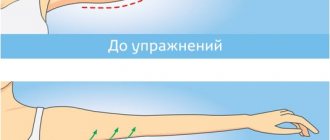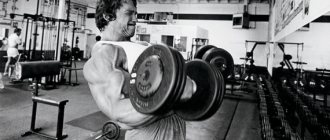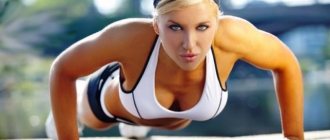Fast and slow muscle fibers
Fast-twitch muscle fibers (glycolytic) are fast-twitch fibers that are strong but fatigue-resistant. For ease of perception, we will shorten their name to the officially accepted abbreviation - GMV .
Slow-twitch muscle fibers (oxidative) are slow-twitch fibers; on the contrary, they are characterized by low strength and low fatigue. For ease of perception, we will shorten their name to the officially accepted abbreviation - OMV .
In our body, everything is thought out to the smallest detail, and muscles are no exception. Depending on the duration and intensity of the load, certain muscle fibers are involved, and their ratio directly affects our athletic achievements. That's why the information below is essential to building every athlete's training program!
White and red fibers are the main
Despite the fact that these two types of fibers are diametrically opposed, they always work in conjunction, replacing each other.
For example, you are training in the gym and started lifting a heavy barbell (no matter how), which in your training you cannot lift more than 2-3 times in one approach (set). In this case, the blow is taken by the white fibers, which are responsible for physical work in an explosive style. That is, you can lift heavy weights, but not for long.
Second example: You took a significant amount of weight off the barbell and started lifting it again. Now you feel ready to do up to 20 repetitions, and you think you can do even more. In this case, red muscle fibers work, allowing the body to perform long-term work. After all, doing 3 repetitions and 20 is a big difference in time.
Third example. You've loaded the barbell with about three-quarters of the weight you can lift at one time (no more) - that's 75%. In this exercise you can do 10-12 repetitions. I will say that in the first lifts of the weight, white fibers actively work, at the end of the exercise the white fibers weaken significantly (we feel tired, but we can continue working), and the red ones are just beginning their work. This is what I was talking about - they replace each other.
Below I will describe in more detail why things are this way.
If these two types are given specific characteristics, then white is strength, red is endurance.
If you think, like I did at one time, that there are only two types of fibers, then you are mistaken. There is also an intermediate type that contains the characteristics of the other two types. He can be both strong and resilient at the same time.
By the way, did you know that the number of certain fibers is not constant in our body? I would like to bring to your attention, friends, that a certain type of training (if you train systematically for a long time) can change the ratio of fibers: today red fibers predominate, and in six months white fibers predominate. This means that you were hardy, but after training for six months, you became strong.
GMV vs OMV
Most likely, you have already heard that the fibers that make up our muscles are of two types: fast-twitch (FMV) and slow-twitch (SMV). More precisely, there is also a third, intermediate type - transition fibers.
The type of fiber is determined by the number of nerve impulses sent to the fiber. The more impulses there are, the correspondingly higher the activity of adesine triphosphatase, as well as the higher the speed of fiber contraction.
Adesine triphosphatase is a special enzyme class of hydrolases that accelerates the process of cleavage of H3PO4 from adenosine triphosphate molecules, which results in the release of energy used for muscle contraction.
GMW (white)
So why are they "white"? It's all about the capillaries they contain, which are much smaller than in OMV, hence the differences in color. In terms of its structure, GMV is, as a rule, several times thicker than OMV. Their response to signals coming from the brain is instantaneous, and the rate of contraction is at least twice as high as that of oxidative ones. Glycolytic fibers receive energy from rapidly absorbed ATP, creatine phosphates and glycogen. It is necessary to understand that these energy sources dry up in just 30-60 seconds. In the process of obtaining energy by fast fibers, oxygen is not involved, due to which energy is released almost instantly, but its reserves are very limited. Based on this, we can conclude that white muscle fibers are suitable for high-intensity, but short-term loads. However, their energy is not enough to perform numerous repetitions and long, monotonous movements.
OMV (red)
They are the exact opposite of glycolytic in their structure and function, and are literally created for light and prolonged loads. They are able to accumulate, store energy, and then gradually expend it, thanks to mitochondria and myoglobin. So, if your muscles are dominated by RMF, you may well be a long-distance runner, aerobic sports are also suitable for you.
Unfortunately, OMVs have much less potential for growth in their volumes and quantities than glycolytic ones. So the increase in our muscle mass is mainly due to GMV.
The ratio of OMV and HMV in our body is predetermined by genetics and we cannot change it. The vast majority of us are dominated by oxidative fibers; in every fourth person, on the contrary, the percentage of glycolytic fibers is slightly higher than red fibers. And only in some athletes the predominance of some muscle fibers over others reaches 85% - they are the ones who have the highest chances of achieving the greatest results in sports.
Fast muscle fibers[edit | edit code]
Development of muscle fatigue in different types of fibers.
Fast muscle fibers
- These are fast-twitch fibers that are characterized by high strength and fatigue. They are larger and hypertrophy quickly. Participate in performing short, high-intensity strength work, that is, during anaerobic training. Due to the low myoglobin content they are white in color.
This type of fiber is important in sports where maximum strength, speed and muscle power are developed:
- All strength sports - powerlifting, bodybuilding, weightlifting, etc.;
- Martial arts;
- Short distance running (sprint).
Skeletal muscle consists of two types of myocytes (muscle symplasts):
- first type:
slow muscle fibers, also known as red or oxidative muscle fibers (OMF); - second type
: fast muscle fibers, also known as white or glycolytic muscle fibers (GMV), which, in turn, are divided into two subtypes:
subtype IIa
and
subtype IIb
. The second type of cells is the most important in bodybuilding, and this is what will be discussed in this article.
The ratio of the number of skeletal muscle cells is determined mainly by genetics, and the athletic potential of each person largely depends on this.
Each muscle cell consists of many myofibrils - these are thin filaments of protein (actin and myosin) that are capable of contracting. Due to the massive contraction of myofibrils, the entire muscle contracts.
| Fiber type | Contraction speed | Capacity for (growth) hypertrophy | Fatigue rate | Is used for | Force | Number of mitochondria | Blood supply | Oxidizing power | Glycolytic capacity | Energy source |
| Type I (slow) | Slow | Small | Low | Aerobic activity (running, cycling) | Low | A lot of | Rich | High | Low | Fats |
| Type IIa (transitional) | High | Small | Moderate | Prolonged anaerobic exercise | High | A lot of | Moderate | High | High | Creatine phosphate, glycogen |
| Type IIb (fast) | Very high | Big | High | Short anaerobic exercise (strength training) | Very high | Few | Meager | Low | High | Creatine phosphate, glycogen |
Fast-twitch, or white, muscle fibers use anaerobic (oxygen-free) metabolism to produce energy for contraction. They perform high-speed movements that are characterized by great or explosive force, but they fatigue much earlier than slow ones. Both types of cells produce approximately the same amount of work per contraction, but white cells do it much faster.
Differences between fast and slow fibers
Type IIa: fast, fatigue-resistant, oxidative-glycolytic
Subtype IIa cells are also known as intermediate or transitional cells. They can use both oxidative (aerobic, i.e., accompanied by the consumption of oxygen) and glycolytic (anaerobic, i.e., oxygen-free) metabolism to produce energy of contraction to an equal extent. These fibers are a cross between fast and slow.
The frequency of nerve impulses is 25-50 impulses/s.
In different people, the ratio of the number of slow and fast fibers in the same muscle is determined genetically and can differ quite significantly. For example, in the human quadriceps muscle, the percentage of slow fibers can vary from 40 to 98%. The higher the percentage of slow fibers in a muscle, the more suited it is to endurance work. Conversely, individuals with a high percentage of fast, strong fibers are more capable of work that requires great strength and speed of muscle contraction.
Type IIb: fast, easily fatigued, glycolytic
These are true fast-twitch muscle fibers. They use only anaerobic metabolism and have maximum strength and speed of contractions. It is these cells that play a primary role in gaining mass in bodybuilding, so almost all training programs are designed to develop this type of fiber.
Of all types of fibers, motor neurons of this type are the largest, have a thick axon that branches into a large number of terminal branches and innervates a correspondingly large group of muscle fibers. Compared to others, these motor neurons have the highest excitation threshold, and their axons have a higher speed of nerve impulses.
The frequency of motor neuron impulses increases with increasing contraction force, reaching 50-100 impulses/s at maximum muscle tension. These motor neurons are not able to maintain a stable frequency of discharges for a long time, that is, they quickly get tired.
Muscle fibers of fast fibers, unlike slow fibers, contain a larger number of contractile elements - myofibrils, and therefore develop greater force during contraction. Due to the high activity of myosin ATPase, they have a higher contraction rate. Fibers of this type contain more glycolytic enzymes, less mitochondria and myoglobin, and are surrounded by a smaller number of capillaries compared to slow MUs. These fibers tire quickly. Most of all, they are adapted to perform short-term but powerful work.
White IIb fibers can hypertrophy to a much greater extent than slow fibers.
In which sports are fast-twitch fibers important?[edit | edit code]
It is this type of cell that makes the main contribution to the achievement of athletic goals in those sports that require explosive strength:
- Weightlifting
- Body-building
- Powerlifting
- Martial arts
- Sprinting
Fast twitch muscle fiber training[edit | edit code]
- Training program for beginners
- Training program for professionals
- Also, do not forget about sports nutrition and a diet for weight gain.
Genetics and bodybuilding[edit | edit code]
Scientists have found that the ratio of slow and fast muscle fibers is genetically determined. The average person has approximately equal numbers. In bodybuilding, the best results are achieved by those athletes whose muscles contain more white fibers.
White muscle fibers are also important for sprinters. Among outstanding sprinters, fast muscle fibers always predominate: about 80%.
There is evidence that the nature of training may influence this ratio. Strength training in bodybuilding can increase the number of type II (a/b) cells, and with aerobic training the content of slow type I cells increases. However, these changes are quite limited. In studies, the transition from one type to another, as a rule, does not exceed 3%. For this reason, some people gain muscle mass with great difficulty, while others, on the contrary, very quickly.
How to determine the proportion of white fibers?[edit | edit code]
- First of all, this can be indicated by your progress in bodybuilding, powerlifting or other strength sports. If all your efforts do not pay off, then we can assume that you have a predominant proportion of slow fibers.
- Perform a Fiber Ratio TEST.
- You can determine the ratio as accurately as possible using electromyography, which determines the exact ratio of your muscle cells.
What to do if there are few white muscle cells?[edit | edit code]
- If you want to get a beautiful figure and look attractive, then this can be achieved even if white fibers are in the minority. Unfortunately, achievements in professional sports will be small.
Muscle fiber training
The main goal of bodybuilders is to increase muscle mass, which mainly depends on the growth of muscle mass.
Glycolytic fibers
To increase their volume, intense short-term loads are used using large weights (60-80% of the repeated maximum) and with constant alternation of muscle groups. The cross-section of fibers increases, as well as energy reserves in the muscles, resulting in muscle hypertrophy.
The duration of one approach is less than a minute. Rest time between sets is 2-4 minutes. Average training frequency – three strength training days a week is quite enough. Exercises are performed at an average pace, neither fast nor slow, with full amplitude; individual phases of the exercises are not highlighted.
Oxidative fibers
The exercises are performed with a light weight of 30-50% of the weight with which you can perform the exercise with only one repetition. An average of 15 to 30 repetitions are performed per set. Approaches 5-8, more possible. It is necessary to perform exercises at a slow or medium pace, without highlighting certain phases of movement. The amplitude of the exercises is full.
3.1. Progressive muscle relaxation
This extremely effective relaxation technique was invented by the American doctor Edmund Jacobson back in 1920. The technique is based on a simple physiological fact: after a period of tension, any muscle automatically relaxes. Therefore, in order to achieve deep relaxation of all the muscles of the body, you need to strongly tense all these muscles simultaneously or sequentially. Dr. Jacobson and his followers recommend tensing each muscle strongly for 5-10 seconds, and then focusing on the feeling of relaxation that arises in it for 15-20 seconds. Jacobson initially developed about 200 special exercises for maximum tension of different muscles, including the smallest ones. But in modern psychotherapy, it is customary to exercise only 16 muscle groups sequentially in this way:
- Dominant hand and forearm;
- Dominant shoulder;
- Non-dominant hand and forearm;
- Non-dominant shoulder;
- Muscles of the upper third of the face;
- Muscles of the middle third of the face;
- Muscles of the lower third of the face;
- Neck muscles;
- Chest muscles and diaphragm;
- Muscles of the back and abdomen;
- Dominant hip;
- Dominant shin;
- Dominant foot;
- Non-dominant hip;
- Non-dominant lower leg;
- Non-dominant foot.
The word “dominant” means right for right-handed people and left for left-handed people.
7 pages, 3452 words
Mental and muscle relaxation
... exercises - for example, from tension directly to relaxation; combining relaxation of some muscles with tension of others. Each of these types of tension has its own unique approach to relaxation...
Of course, there are more detailed methods of progressive relaxation (for 30, 40 muscle groups, and so on).
Those wishing to achieve a high degree of mastery in relaxation should use these more sophisticated techniques. But to achieve a general therapeutic effect, 16 groups are quite enough.
Let's take a closer look at exercises for some muscle groups.[9]
Relaxation of arm muscles.
Exercise 1.
Lie quietly in the starting position for about five minutes. Then bend your left hand at the wrist so that your palm is vertical, hold it in this position for several minutes; the forearm remains motionless. Watch for a feeling of tension in the muscles of your forearm. Relax your hand, allowing your hand to fall onto the blanket under its own weight. Now your hand cannot help but be relaxed - after such muscle tension, relaxation is a physiological need. For a few minutes, notice the feeling of relaxation in your hand and forearm. Repeat this exercise again. Then spend half an hour at rest. The most important thing is to learn to recognize the sensations of tension and relaxation.
Exercise 2.
The next day, repeat the previous exercise. After the second relaxation of the hand, bend it at the wrist away from you, fingers down.
Exercise 3.
Today you are resting. Do only relaxation, while paying attention to the sensations in your left hand.
Exercise 4.
Let’s add to the first and second exercises the experience with the elbow joint flexor. Bend your left arm at the elbow at an angle of 30 degrees, that is, lift it from the blanket. Repeat this operation three times for about 2 minutes, followed by relaxation for several minutes. Relax for the rest of the hour.
Exercise 5.
Repeat all previous exercises. Then we will train the triceps. You will achieve tension in this muscle if, placing a stack of books under your forearm, you forcefully press on them with your lying hand. Alternate tension and relaxation three times (for relaxation, move your hand away from your body, behind the books you use as an aid).
Relax for the rest of the hour.
Exercise 6.
An hour of repetition. Do the four exercises you know for your left hand.
Exercise 7.
This exercise will show you how successfully you have mastered all the previous ones. Your task is to lie quietly with your arms extended along your body. You will achieve tension without moving your left hand, solely by concentrating your attention on it. Focus on tension for about half a minute, then release it into relaxation. Repeat this several times. Relax again for the rest of the hour.
In the future, do the same with your right hand (that is, seven exercises in total).
Relaxation of leg muscles.
You can start by repeating the arm exercises, but this is not at all necessary. If you have already learned to recognize tension and relaxation in each muscle group and are able to control these processes, then you can immediately begin relaxation. So, relax your whole body, you will train only your legs (first the left, then the right).
Exercise 1.
Bend your knee - tense the muscles in the upper leg and below the knee. We train in a threefold alternation of tension and relaxation. Exercise 2.
And now, on the contrary, we bend the limb with the toe towards us. Calf tension and relaxation.
Exercise 3.
Tension and relaxation in the upper thigh - the trained leg hangs off the bed (sofa, etc.), thereby achieving tension. Then return your leg to the starting position and focus on relaxing.
Exercise 4.
Tension in the lower thigh - achieved by bending the leg at the knee. Exercise 5.
Tension in the hip and abdomen - elevate your leg so that only the hip joint is flexed. Exercise 6.
Tense gluteal muscles - place several books under your knee and press hard on them.
Discharge these six exercises with one or two repetition sessions, or provide one session devoted exclusively to relaxation.
Relaxation of the trunk muscles.
Exercise 1.
Abdominal muscles - we perform it as follows: either we consciously draw our stomach into ourselves, or we slowly rise from a lying position to a sitting position.
Exercise 2.
Muscles located along the spine - tension is achieved by bending and arching in the lower back (while lying on your back).
Exercise 3.
Muscles of the respiratory system. Before starting the exercise, it is recommended to do about half an hour of general relaxation. Then take a series of deep breaths and exhalations. At the same time, you will constantly feel the tension that arises in the chest when you inhale (it is possible that at first you will only notice tension under the sternum; thanks to training, you will easily learn to recognize it in other parts of the chest).
Once you understand the general pattern of tension during deep breathing, you will be able to identify it during normal breathing. The purpose of this exercise is not to control breathing (as in a number of other relaxation techniques), rather on the contrary - we are talking about freeing this process from the arbitrary influence of volitional factors, so that it functions absolutely spontaneously.
Exercise 4.
Relaxation of the shoulder muscles. Involves the acquisition of several skills. By crossing your arms outstretched forward, you will fix the tension in the front of the chest; by rotating the shoulders back - tension between the shoulder blades, by lifting them - tension on the sides of the neck and in the upper part of the shoulders themselves. Tension in the left side of the neck is achieved by tilting the head to the left, in the right - to the right. It is fixed in the front and back sides when the head is tilted forward and backward. This shoulder relaxation exercise can be done in one step, but it can also be done in stages.
Generally, trunk relaxation exercises should be carried out for about a week (if you find it necessary to consolidate some skills, in this case, consider classes devoted exclusively to relaxation).
Relaxation of the eye muscles.
Exercise 1.
Tension in the forehead - is achieved by shifting the skin on the forehead into wrinkles. Exercise 2.
Tension of the muscles of the eyelids - we move our eyebrows, our eyes are tightly closed.
Exercise 3.
Tension of the extraocular muscles - in this case we feel tension in the eyeball. With our eyes closed, we look right, left, up, down. We train until we are able to clearly recognize tension, and thereby get rid of it (that is, relax these muscles).
Exercise 4.
Tension of the extraocular muscles - having mastered the previous exercise, open your eyes and watch what happens when you look from the ceiling to the floor and vice versa. Feel the tension and relaxation.
Relaxation of facial muscles.
Exercise 1.
Gritting your teeth, observe in every detail the tension accompanying this. Relax. Repeat the exercise several times. Exercise 2.
Open your mouth. You should feel tension in front of your ears, but only more deeply.
Exercise 3.
Bare your teeth, watch the tension in your cheeks. Relax.
Exercise 4.
Round your mouth as if to say “oh!”, feel the tension, then relax your lips.
Exercise 5.
Moving your tongue back, watch the tension and relax.
Relaxation of mental activity.
A quarter of an hour after complete relaxation, imagine (with your eyes closed) that you see the ceiling and floor of the room in which you are. If what you imagine is effective, you will feel the same muscle tension that you would experience when performing this task “in reality”. Relax for five to ten minutes. Then imagine a wall to your left and to your right. The goal is to develop the ability to evoke an intense mental image, and thereby tension in the corresponding muscle groups.
Later (again after relaxation), imagine that a car is driving past you. You can practice in a similar way with any moving objects; you can imagine that a train is going by, a plane or a bird is flying by, a ball is rolling, etc. Having felt the tension in your eyes when mentally imagining moving objects, focus on imagining tension in the eye muscles when “observing” stationary objects, for example, imagine yourself reading a book. - or books. This approach leads to “clearing thoughts” - already during or after the exercise you will feel that your thoughts have calmed down, have stopped bothering you, none of them flashes in your brain.
For mental calm, Jacobson recommends imagining yourself talking to other people. If the imaginary intensity is intense, you will feel tension in the tongue, throat, lips, and in some cases, tension in the jaws.
Fibers illustrated
In order to fully understand what GMV and OMV are and what they look like, there is nothing better than seeing them with your own eyes. And it's very easy to do. Do you eat chicken? The fact is that it is chicken meat that best reflects the location of glycolytic and oxidative fibers in the poultry body. Surely many of you have noticed that chicken meat in the area of the breast and wings is white, and it contains practically no fat, while the meat of chicken legs and thighs has a dark red color and a higher fat content. The thing is that a chicken, like most other poultry, spends almost all its time standing, which means that the muscles of its legs are subject to constant static load (i.e., oxidative fibers are involved). At the same time, the wings are used extremely rarely and only for quick, energetic flapping, which characterizes the work of glycolytic fibers.
How to determine which muscle fibers predominate
This can be done by sending tissue samples to a laboratory for testing, or by doing a muscle fiber ratio test yourself. Let's look at how to do this using the example of the exercise, lifting dumbbells for biceps:
- 1) you need to choose a weight of dumbbells at which you can perform only one repetition of this exercise - this will be the maximum weight
- 2) after this you need to rest for about 15 minutes and perform this exercise with a weight that is 80% of the maximum exactly as many times as you can do it without additional help
- 3) based on the number of times obtained, interpret the results
- 4) do the same with all major muscle groups










